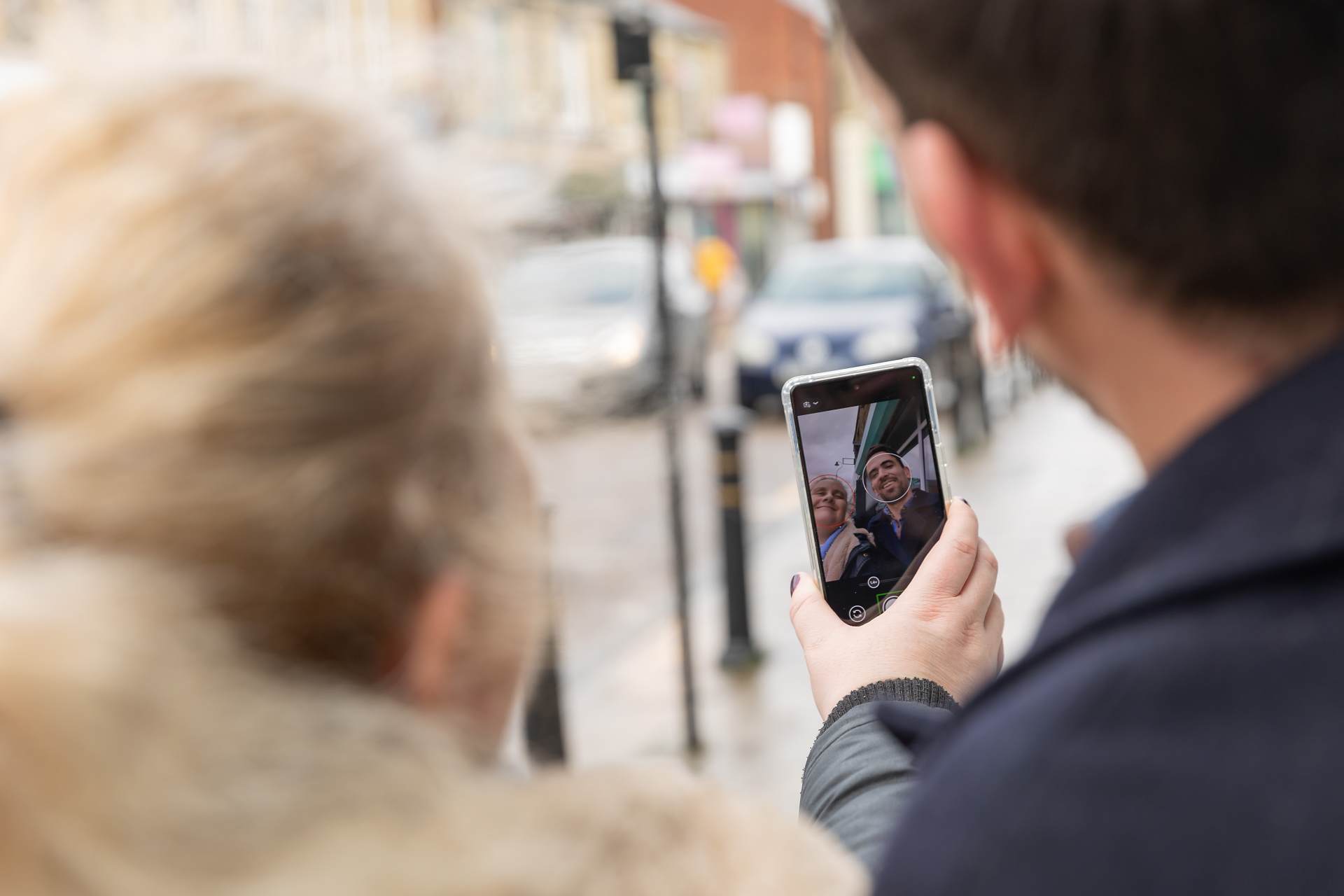Screen readers and text to speech software
Screen readers and text to speech software convert written or visual content into audio. If you have a vision impairment, screen readers can help you access digital content, like social media, web pages, accessible PDFs, images, or even emojis. When paired with a refreshable Braille display, a screen reader can even convert digital content into Braille.
In other words, assistive technology means that access to the online world is possible without needing to see a screen.
On this page
How screen readers work
Screen readers use software to read text on your screen aloud in a human-sounding voice. In this sense, they act as a translator between you and a computer.
Some devices have built-in screen readers, but you might have to download an extension if your device doesn’t come with one. Screen readers are compatible with most devices and software; some are free but some you have to pay for.
How does text to speech software differ from screen readers?
Although text to speech software and screen readers are similar in the sense that they both read digital content aloud, there are some important differences between the two. Screen readers offer far more capabilities: in addition to translating digital content into speech, they offer audio or haptic (tactile) feedback to help with page navigation, you can use screen readers to jump between sections of a document, and they can be operated using keyboard shortcuts or gestures on a phone / tablet screen.
A screen reader could be the best tool if you’re having difficulty using a device. For example, if you’re struggling to access menus or it’s tricky to find things on the screen, then a screen reader would be ideal. However, if you need assistance with something like reading a long paragraph of text, then text to speech software might be the best choice for you.
If you have a vision impairment, a screen reader will grant you greater independence than text to speech software. Here’s how Siobhan’s screen reader has helped her:
Screen readers have transformed my life, granting me access to digital information and online services with ease. As a blind person, tools like JAWS for Windows have empowered me to navigate the digital world confidently, whether I'm shopping, enjoying entertainment, or advancing in my career.
In this video, Cerys explains how they use a screen reader for inaccessible documents.
The top screen readers people use
We consulted our subject matter experts to see which screen readers work well with different technology brands or programmes. We’ve summarised them here, so have a read to see if there’s one that meets your needs.
VoiceOver screen reader for iOS
VoiceOver for iPhones and iPads
VoiceOver is the built-in screen reader on iPhones and iPads and it lets you interact with your device without seeing the screen. You can interact with the screen using gestures and VoiceOver will relay back the information using speech. It’s free, and you can access it by heading to Settings > Accessibility > VoiceOver on your Apple device.
VoiceOver for Mac
Like the VoiceOver function on iPhones and iPads, VoiceOver for Mac is free and built into the device. However, you interact with the feature using keyboard shortcuts, arrow keys, the mouse, or gestures on the trackpad.
TalkBack for Android
TalkBack is automatically installed on most Android devices, and is free to use. You can use gestures to interact with the phone or tablet and TalkBack will provide audible information. You can download it from the Android Accessibility Suite on Google Play Store.
Windows screen readers
Narrator for Windows
Narrator is the built-in screen reader on Windows computers. You interact with the software using keyboard shortcuts, Braille display or keyboard, or the mouse or trackpad, and get spoken feedback that enables you to use the computer. Be aware that you might need to change your settings to use Narrator with a mouse.
You can access Narrator by pressing the Windows Key, Control, and Enter simultaneously. Narrator is free to use and it’s popular because it allows any user access to a computer without downloading additional software.
JAWS for Windows
JAWS stands for Job Access With Speech and it’s a screen reading software package available for Windows computers. It’s designed to provide spoken feedback and Braille access for computers. Most people use keyboard shortcuts with JAWS, but you can also use it with a mouse or Braille keyboard. You can even set up custom keyboard shortcuts for actions that would otherwise be inaccessible.
You can buy JAWS in the UK from Sight and Sound for £750 – this gets you a home licence. Licences can also be provided for work computers, either bought by your employer or through an Access to Work scheme.
NVDA for Windows
NVDA, short for NonVisual Desktop Access, is a free screen reading programme available for Windows computers. You interact with NVDA in a similar way to JAWS, Narrator, or VoiceOver for Mac – you mostly use keyboard shortcuts, but you could also use a mouse or Braille display. As it’s free to download from the NV Access website, we recommend everyone tries NVDA before paying for JAWS.
SuperNova for Windows
Designed for Windows software and computers, SuperNova gives you access to Office 365 and many Windows-compatible browsers thanks to its speech features. There are three SuperNova packages, ranging from £525 - £1375, with the most premium package including Braille support. Supernova is a magnification software first and foremost, and to get the screen reader version you would need to buy the "Supernova Magnification and Screen Reader" package.
More screen readers to choose from
There are also various screen readers available for specific devices and software, like ChromeVox that’s designed for Google’s own web browser and Chromebooks.
Free and built-in text to speech software
Many modern devices come with text to speech software already installed. These are the most popular built-in options you might come across.
Text to speech on iPhone and Apple
Apple devices, like iPhone, iPad, and Mac, come with free built-in text to speech software called Speak Selection and Speak Screen. To access them, head to Settings > Accessibility > Spoken Content. From there you can turn on Speak Selection or Speak Screen, choose from over 40 voices, or change the language and the speech rate.
Text to speech on Android
To use text to speech on Android, you can use the "Select to Speak" function, accessed through accessibility settings. Then, enable the Select to Speak shortcut. This puts a button on the side of your screen that, when pressed, reads selected text or all text on the screen when the play button is pressed.
Text to speech on Microsoft Windows
The most popular Microsoft apps, including Word, Outlook, PowerPoint and OneNote, have a free built-in text to speech function called Speak. You can add Speak to your Quick Access toolbar found at the top right of these apps by clicking Customize Quick Access Toolbar > More commands > In the “Choose commands from” list, select All Commands > Add Speak.
Alternatively, use the Read Aloud function in apps like Microsoft Word or Microsoft Outlook to hear your documents or emails read aloud. You can even adjust the voice and reading speed when the Read Aloud tile appears.
Paid text to speech software
Although most text to speech software is free, there are some paid options in the form of apps or browser extensions. If you often rely on text-to-speech software, a paid version could be a good investment as it offers greater accuracy and reliability, more natural-sounding voices, and greater customisation options compared to free versions.
Choosing the right screen reader or text to speech software
What to consider when choosing your screen reader or text-to-speech software:
- Cost
- The ability to customise
- Language availability
- Speed of speech
- Complexity
- Compatibility with your device
If you would prefer to watch the video without an audio description, there is a non-described version here.
Grants for screen readers and text to speech software
Institutions like RNIB offer a Technology Grant Scheme, through which you can apply for screen reading software and other equipment. Alternatively, Gardner’s Trust for the Blind offers grants for computer equipment and software. For any software needed to perform your role at work, your employer or Access to Work should be able to provide suitable software.
Other devices
As technology is developing and the need for screen readers is more widely recognised, new devices often come with integrated screen readers or audio options. For example, the next time you get a new TV, games console, or Amazon Fire Stick, check the device’s accessibility options to see if they provide assistive technology.
You might also like…
Looking for recommendations on products and apps that can help you with your daily activities?
Frequently asked questions
Related content
- Headphones to help people with vision impairment
- Smartwatches for people with vision impairment
- Tech selector
- Apple parental controls
- Apps to Help People with Vision Impairment
- How to read braille
- Screen Readers and Text to Speech Software
- Talking kitchen scales
- Webinars
- Internet safety
- Internet safety for kids
- Alexa skills
- Best apps for navigating public transport
- Best smart thermostat
- Braille printer
- Large print keyboard
- Smart heater
- Smart lighting
- Smart plug
- Talking clock
- Tech for All learning programme
- What is the Amazon Echo
- What is braille?
- Watching TV with a vision impairment
- Android accessibility features
- Apple accessibility features
Edited and reviewed by Vision Rehabilitation Specialist Chris Moore on 14/11/2024
Guide Dogs is committed to integrating technology into our service delivery and promoting excellence in accessibility and usability. Our staff undergo comprehensive training in technology and accessibility in collaboration with industry leaders like Apple. We foster knowledge of technology and create content through our Technology Champions, comprising Vision Rehabilitation Specialists and Habilitation Specialists. We review this content periodically to ensure that it is up to date and includes new features and changes with operating systems. We work with our partners to ensure accessibility is at the centre of the design. To find out more, there is more information in our accessibility policy.
Whilst Guide Dogs may be able to suggest various third-party websites and third-party applications which may be able to assist you, those are not endorsed by Guide Dogs. Guide Dogs have no control over those third parties and cannot be held responsible for the accuracy of information and support they can provide or the suitability and quality of any products or services they provide.



